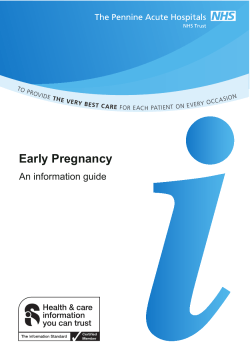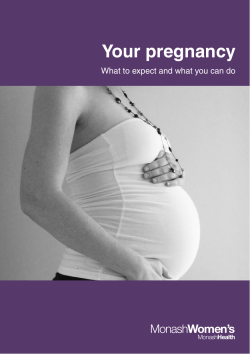
EVALUATION OF PULMONARY FUNCTION TESTS NON PREGNANT WOMEN
EVALUATION OF PULMONARY FUNCTION TESTS IN NORMAL PREGNANT (II & III TRIMESTER) & NON PREGNANT WOMEN F IRST AUT HO R: Name :, Dr. Lata Gupta Designation Associate Professor :, Department Address :, Department of Physiology, G.M.E.R.S. Medical College, Sola, Ahmedabad. CO AUT HO R: Na me : , Dr. R. Di x it De s i g na ti o n :, De p u t y Di r e c t or – Me di c al Ed u c a ti on De pa r t me n t Ad d r e s s :, He a l t h, Me d i ca l Se r vi c e s a nd Me d i ca l Ed u c a t io n , ‘G ’ Bl o c k , Ci vi l Ho s pi tal , G a n d hi n a ga r. CO RRESPO ND ING AUT HO R: Na me : , Dr. La ta Gup ta De s i g na ti o n :, As s o c i a t e Pro f e s s o r De pa r t me n t Ad d r e s s :, De pa r t me n t o f Ph y s i ol o g y, G. M. E. R. S. Me d i c al Coll e g e , Sol a , Ah me d a b a d . Co r r e s p on d e n c e Ad dr e s s : , E ma i l dr _l a ta @r e di ff ma i l . co m ABST RACT Pregnancy is principally a pheno men on of maternal adaptation to the increasing demands of the gro wing fetus 1 . Pregnancy cause s many visible and invisible changes in hu man body and it represents one of the best e xa mple of selec tive adaptation in terms of respiratory physiology. BACKGRO UND: To evaluate the changes in dynamic pulmonary function tests (PFTs) in IInd & IIIrd trimesters of pregnancy and co mpare the results between nor mal pregnant wo men ( case group) & nor mal non pregnant wo men of IInd & IIIrd trime st ers (control group). DESIG N (MAT ERIAL & MET HOD): 50 Sub jects were divided into two groups, non pregnant wo men (n = 20, mean age = 26.5 ± 2.69) and nor mal pregnant wo men’s of II & III trimesters (n = 30, mean age = 24.8 4 ± 3.00) . PFTs were done by medspiror. RESULT S : Significant decrease in all the parame ters of PFTs like Forced Vital Capacity (FVC), Forced Expiratory Volume in one second (FEV 1 ), Peak Expiratory Flow Rate (PEFR), Ma xi mu m Ventilation Volume (MVV), were seen in II & III trimester of normal pregnant wo men as co mpared to nor mal non pregnant wo men. CONCLUSIO N : Our data suggests that there is alteration in PFTs in pregnant wo men. Continuous Monitoring of PFTs may prove to be of great value in maternal healthcare as cases of restriction and obstruction in lungs during pregnancy can be identified early and its deterioration can be prevented by proper manage ment. KEY WORDS : PFTs Pregnancy EVALUATION OF PULMONARY FUNCTION TESTS IN NORMAL PREGNANT (II & III TRIMESTER) & NON PREGNANT WOMEN INT RODUCT ION: Preg nanc y causes ma ny visible and invisible c ha nges i n huma n body. T he hig hl y efficient and s ensiti ve respi ratory s yste m becomes vul ne rable with profound changes duri ng pregna nc y where adaptability is a ke y feature t o combat stress, anxiet y a nd fear resulting demands 1 . in alte red performance of systems to need Pul mona ry function tests (PFT S ) permit an acc urate a nd reproducible assessme nt of the f unctional state of respiratory system a nd allow qua ntification of the se verit y of disease. Vario us investigators 4 , 11 ha ve studi ed pulmonary function tests (PFT S ) during no rmal p regna nc y but thei r res ults were conflicting. Out of va rious pul mona ry function tests medspiror assess FVC, FEV 1 , PEFR, MVV, etc. T he scanty literature on p ulmo na ry function testing during pregnanc y has pro mpted the present work. MATERI AL AND METHODS : About 50 sub jec ts were e xa mined for PFTs. In this linear study groups, 30 pregnant wo men were taken for case study and 20 nor mal fe male were e xa mined for PF Ts for control study. About 30 fe male pregnant patients belonging to the 20 -30 yrs of ag e volunteered themselves for the prese nt study belonging to middle socio economic status and co me for regular check up in hospital as OPD basis. Young healthy nor mal non pregnant wo men of child bearing age (20-30 yrs) from medical faculty and also fro m those who ac co mpanied the case sub jects were selected for control group. General physical exa mination of the s ubject including required anthropome tric measures such, as height, weight and chest circumference was noted. Resting body te mperature resting pulse rate, and Blood Pressure were taken in sitting p ostured after half an hour of rest for every time when they co me for pulmonary function testing. Anthropometric measures suc h a s height, weight was noted. In standing posture, d uri ng late morni ng session, after taking consent a nd explained the procedure to the s ubjects and they we re asked to take maximum deep inspiration then blow out with maximum effort in mout h piece of medspiiror which already apposed between the lips firml y. Nose was closed by nose clips. As two readi ng for PFTs were taken o n i nstrume nt and the highest one selected for cal culation. The instrument was fed with the data, height in centimeters age in years, weight in Kilograms, se x and roo m te mperature prior to perfor mance of a FVC maneuver. T he specifications of Instrument provides flow rate L/Sec versus volume (L) plot and provides volume verses time plot recordings on ther mo sensitive paper. Results of PFTs displayed and recorded as follows : FVC – Forced Vital Capacity FEV1 – Forced Expiratory Volu me in one second PEFR – Peak Expiratory Flow Rate MVV – Ma xi mu m Ventilation Volume T he actual values as measured duri ng the mane uve rs, predicted val ues for the specific patient, w hen compared to othe rs of same age, height, sex or perce ntage predicted values, i.e. a ratio of actual val ue and p redicted val ue expressed a s percentage are displayed and if resources a vailable pri nted records can be obtained. The PFTs data’s are e xa mined by medspiror and a diagnosis of obstructive or restrictive disease is made and there are a number of syste ms which used to deter mine the severity of disease. Here is just one way that is very co mmonly us ed 11 . Normal PFT outcomes Mild Disease Moderate Disease Severe Disease predicted values : : : >85 % of predicted val ues >65 % but <85 % of predicted val ues >50 % but <65 % of predicted val ues : <50% of If both FVC and FEV 1 a re normal, then patient has a normal PFT tests. If FVC a nd/or FEV 1 , is 80-90 % or hig her, the n patient has restricted l ung disease. If t he % p redicted for FEV 1 /FVC is 69 % or lower, t hen t he patient has a n obstructed lung disease. RESULTS AND O BSERVATION: Statistical analysis was done for all para meters undertaken in study along with so me investigative paramet ers. The age ranged bet ween 20-30 yrs in both groups. The figures of range have been rounded off, second & thi rd trimesters are abbre viated as II, III respectivel y i n all tables & graphs. Percentage difference (% diff) for increase or decrease in any para meter was calculated, considering the mean values of controls (non pregnant subjects) as baseline when co mpared with the case group (two different tri mesters). On co mparing control versus second trimester and third trimester, mean values of control were taken as baseline. Mean values of second trime sters were considered 100%, when this gr oup wa s co mpared with third trimester group. The positive value in percent difference depicts the increase and negative value as the decrease for that para meter. Unpaired 't' test by OS 3 progra mme (co mputer), was done to find the level of significance as nu mber of control subjects is differ fro m the nu mber of case group. . That were significant when these respiratory parameters of different o f pregnancy were co mpared trimesters with each other and with non pregnant state (Control group). The calculated 't' values and corresponding 'p' values are given for various sa mple groups for all the respiratory parameters. TABLE - 1 STATISTICAL ANALYSIS FOR FORCED VITAL CAPACITY (Lt/Sec.) IN DIFFERENT CONTROL AND IN II & III TRIMESTER OF PREGNANCY Sample Mean ±SD Range % 't' 'p' difference values values Significant Control vs II 2.13 0.21 0.78- -15.9 NS 1.79 0.50 3.26 Control vs III 2.13 0.21 0.66- 1.37 0.49 2.34 1.79 0.50 1.37 0.49 II vs III -2.842 0.0068 (<0.0) -35.6 -6.466 0.0000 HS -23.4 3 S 0.0043 (0.005) GR APH -1 GRAPHICAL REPRESENTATION OF FVC (Lt/Sec.) IN CONTROL AND IN II & III TRIMESTER OF PREGNANACY Decrease in forced vital capacity fro m second tri mester to third trimester is less significant while decrease in FVC from control to third trimester is highly significant. TABLE - 2 STATISTICAL ANALYSIS FOR FORCED EXPIRATORY VOLUME IN ONE SECOND FEV1 (Lt/Sec.) IN CONTROL AND IN II & III TRIMESTER OF PREGNANCY Sample Mean ±SD Range % 't' 'p' Significant difference values values Control vs 1.96 0.23 0.70- II 1.57 0.41 2.28 Control vs 1.96 0.23 0.52- III 1.23 0.45 2.24 II vs III 1.57 0.41 1.23 0.45 -19.8 3.797 0.0005 S (<.001) -37.2 6.589 0.0001 HS -21.6 2.793 0.0075 LS (<0.01) GRAPH – 2 GRAPHICAL REPRESENTATION OF FEV1 (Lt/Sec.) IN CONTROL AND IN II & III TRIMESTER OF PREGNANACY Table-2 shows that forced e xpiratory volume in one second (FEV1) in non pregnant subjects is higher than in pregnant subjects. It also shows that FEV1 de creases upto late pregnancy. W hen compared with control the decrease in mi d and late pregnancy i.e. second and third trimester is highly significant. The decrease fro m mid to late pregnancy is less significant. TABLE - 3 STATISTICAL ANALYSIS FOR PEAK EXPIRATORY FLOW RATE (PFFR) IN CONTROL AND IN II & III TRIMESTERS OF PREGNANCY Sample Mean ±SD Range % 't' 'p' difference values values Significant Control vs II 5.40 0.55 1.8-6.0 -27.7 5.601 0.0000 HS 3.90 1.09 5.40 0.55 0.8-4.5 -50.3 10.315 0.0000 HS 2.68 1.07 3.90 1.09 -31.28 3.994 0.082 HS Control vs III II vs III 2.68 1.07 (<0.001) GRAPH – 3 GRAPHICAL REPRESENTATION OF PEFR (Lt/Sec.) IN CONTROL AND IN II & III TRIMESTER OF PREGNANACY Table - 3 shows statistically decrease in PFFR from non pregnant to mid & late pregnant state i.e. when se cond and third trime ster were co mpared with non pregnant state, the decrease in values were statistically highly significant. W hen PEFR values of second trimester & third trimester was co mpared, it was observed that decrease in PEFR vales were insignificant. TABLE - 4 STATISTICAL ANALYSIS FOR MAXIMUM VENTILATION VOLUME (MVV) (Lt/sec.) IN CONTROL AND IN II & III TRIMESTERS OF PREGNANCY Sample Mean ±SD Range % 't' 'p' difference values values Significant Control vs II 70.65 14.81 39-83 -26.61 5.390 0.0000 HS -40.24 8.123 0.0000 HS -10.57 3.356 0.0016 S 57.72 11.25 Control vs III 78.65 14.01 34-69 47.00 11.34 II vs III 57.72 11.25 47.00 11.34 (<0.005) GRAPH – 4 GRAPHICAL REPRESENTATION OF MVV (Lt/Sec.) IN CONTROL AND IN II & III TRIMESTER OF PREGNANCY Table - 4 shows mean values in t he table clearly depict that ma xi mu m voluntary ventilation (MVV) per minute decrease to a great extent in case groups when co mpare d with control group. This is obvious from the high 't' values showing highly significant decrease in ma xi mu m voluntary ventilation. MVV decrease by almost half that is by 40.24% in late pregnancy as compared to non pregnant state and by one third that is 26.61% as co mpared to second trimes ter. Respiratory parame ters sho ws significant changes when third trimester values of case group were co mpared with non pregnant state (Control group). The calculated 't' values and corresponding 'p' values are given for various sample groups for all the respiratory para meters. : DISCUSSION : PFTs were conducted with the help of medspiror. All the results were sta tistically analyzed. The results of PFTs para meters are briefly tabulated in table 1,2,3,4 for inferring the changes that have occurred at glance and co mpared with various studies that have already published. GRAPH : 5 COMPARISION OF FVC VALUES OF PRESENT STUDY WITH OTHER STUDIES So me studies 3 sho ws significant rise in FVC. Mostly all studies 4 , 5 , 6 sho w decrease in FVC. Significant reduction in FVC ma y be obtained due to restrictive effect of the enlarging uterus 4 . FVC is diminishing due to augmentat ion of rib cage volume displacement, relative mobility of thoracic cage and unimpaired diaphragmatic mo ve men ts 4 . GRAPH : 6 COMPARISION OF FEV1 VALUES OF PRESENT STUDY WITH OTHER STUDIES FEV 1 is essential to access ventilatory capacity pulmonary or to access the ability to ventilate 2 . of the A nu mber of studies 4 , 6 , 8 , 9 as revie wed show de crease in FEV 1 . No change in FEV 1 seen in fe w studies 3 , 5 . Decline in FVC and FEV 1 due to mechanical pressure of enlarging gravid uterus, elevating the diaphragm and restricting move men ts of lungs 4 , 6 , 9 a nd thus ha mpering the forceful expiration. It may also be due to bronchoconstrict effect of decreased aveolar PCO 2 on the bronchial smooth muscles 3 , 6 . GRAPH : 7 COMPARISION OF PEFR VALUES OF PRESENT STUDY WITH OTHER STUDIES All st udies 5 , 6 statistically significant, decli ne in PEFR. s hows T he restriction bro ught about b y e nlarged breast growi ng gravid and t he fea r of co mplications arisi ng at te rm due to abdominal pressure req uired to forcefull y inspi re and expire for executing flow rates could render lowered val ues d uri ng preg nanc y. T he mechanical effects of gra vid uterus cause relati vel y adaptive changes in p ulmo nary mecha nics 1 0 . GRAPH : 8 COMPARISION OF MVV VALUES OF PRESENT STUDY WITH OTHER STUDIES All studies 6 , 11 s how significant decl ine i n mea n val ues of MVV. MVV decrease duri ng pregna nc y i ndi cating of a mecha nical inhibition of chest 4 . T he decrease MVV ma y also be attributed to an inc reased oxygen per unit of work done in the respirato ry muscles scar. CONCLUSIO N: In control subjec ts, pul monary funct ion tests by med spiror were within nor mal range. In second & third trimester of normal pregnant subjects, pulmonary function tests were seen lower as co mpared to nor mal non pregnant state. FEV 1 , FVC decrease in pregnant ca se group providing that pregnancy is a restrictive condition and not obstructive, the decrease in values of these para me ters also suggests that dysfunction of e xpiratory muscle is not there though weakness may be there and mechanical properties of respiratory system are normal that are due to altered configuration affecting elastic recoil of chest and intra thoracic diameter. Peak Expiratory Flow Rate ( PEFR) decreases states that it might be caused by up ward displace ment of diaphragm, reduced strength of expiratory muscle s and mechanical effect of growing uterus. Other factors as morning sickness, lack of motivation and resistance to exertion contribute in decreasing Maxi mu m Ventilation Volume (MVV). Because of abdo minal distension, there is gradually fall in all pulmonary function tests values. The importance of continuous antenatal surveillance and therefore use of pulmonary function t est by med spiror is thus evident in early identification of suspected and established cases of restriction and obstruction in lungs during pregnancy. The disease can be identified early and its deterioration can be prevented by proper manage ment. REFERENCE : 1. Dutta DC. Physiological Changes during Pregnancy, Obstetr ics and Gynecology, 4th Ed i. Calcutta : Ne w Central Book Agency ; 1998 : 46-57. 2. Cotes JE. Lung Function assess ment and applicati on in medicine, 3rd Edi. O xford : Black well scientific publications ; 1975 : 93-105. 3. Milne JA, Mills RJ, Howie AD, Pack AI . Large airways function during normal pregnancy. Br. Jr. of Obst. and Gynaec 1977; 84 : 448 - 451. 4. Puranik BM, Kaore SB, Korhade GA, Agra wal SD, Pat wardhan SA, Kher JR. A longitudinal study of pulmonary function tests during pregnancy. Indian J. Phys iol Pharmacol 1994; 38(2) : 129 - 132. 5. Mokkapatti R, Prasad EC, Venkatra ma n, Fatima K. Ventilation functions in pregnancy. Indian J. Phys iol and Pharmacol 1991; 34(4) : 237 - 249. 6. Monga U, Ku mar K. Pul monary functions in Punjabi Pregnant Women. Ind ian J. Phy s iol Pharmacol 2 000 ; 44(1) : 115-16. 7. Sheikh AM, Deshpande DR, Ganeriwal SK, Reddy BV. Effect of Pregnancy on Vital Capacity and F EV 1 . J. Obst. and Gynaec . India 1983 ; 33 : 495 - 499. 8. Phatak MS, Kurhade G A. A Changes in Lung Function Parted Exercise in their Pharmacol 2003 ; 47(3) : 352 Longitudinal Study of Antena tal Tests a nd I mportance of Post Recovery. Ind ian J. Phys io l, - 356. 9. Pandya MR, Nishith SD, Bhatt RV. Pul monary function in pregnancy. J. Obst. and Gynaec. India 1972 ; 22(1) : 1-3 10. Fishman AP. The Lung in Pregnancy. In: Fish man's (ed). Pulmonary Disease and Disorders. 3rd Ed it ion. Ne w York : Mc Graw Hill ; 1998 : 243 251. 11. Chhabra S, Nangia V and Ingla KW ; Changes in Respiratory Function Tests during Pregnancy. Jr. of Phys io l and Pharmac ol 1987 ; 32 (1) : 56-60. 12. Gupta L, Dixit R ; Study of Pulmonary Function Tests (PFTs ) in Normal Pregnant Women of Third Trimester, IMJ 20 11 ; 105(2) : 67 – 70.
© Copyright 2025





















